Leadership Theories and Examples of Transformational Leaders
VerifiedAdded on 2023/06/13
|5
|941
|485
AI Summary
This article discusses different leadership theories including Path Goal, Likert's model and Transformational leadership. It also provides examples of transformational leaders like Nelson Mandela and Elon Musk.
Contribute Materials
Your contribution can guide someone’s learning journey. Share your
documents today.
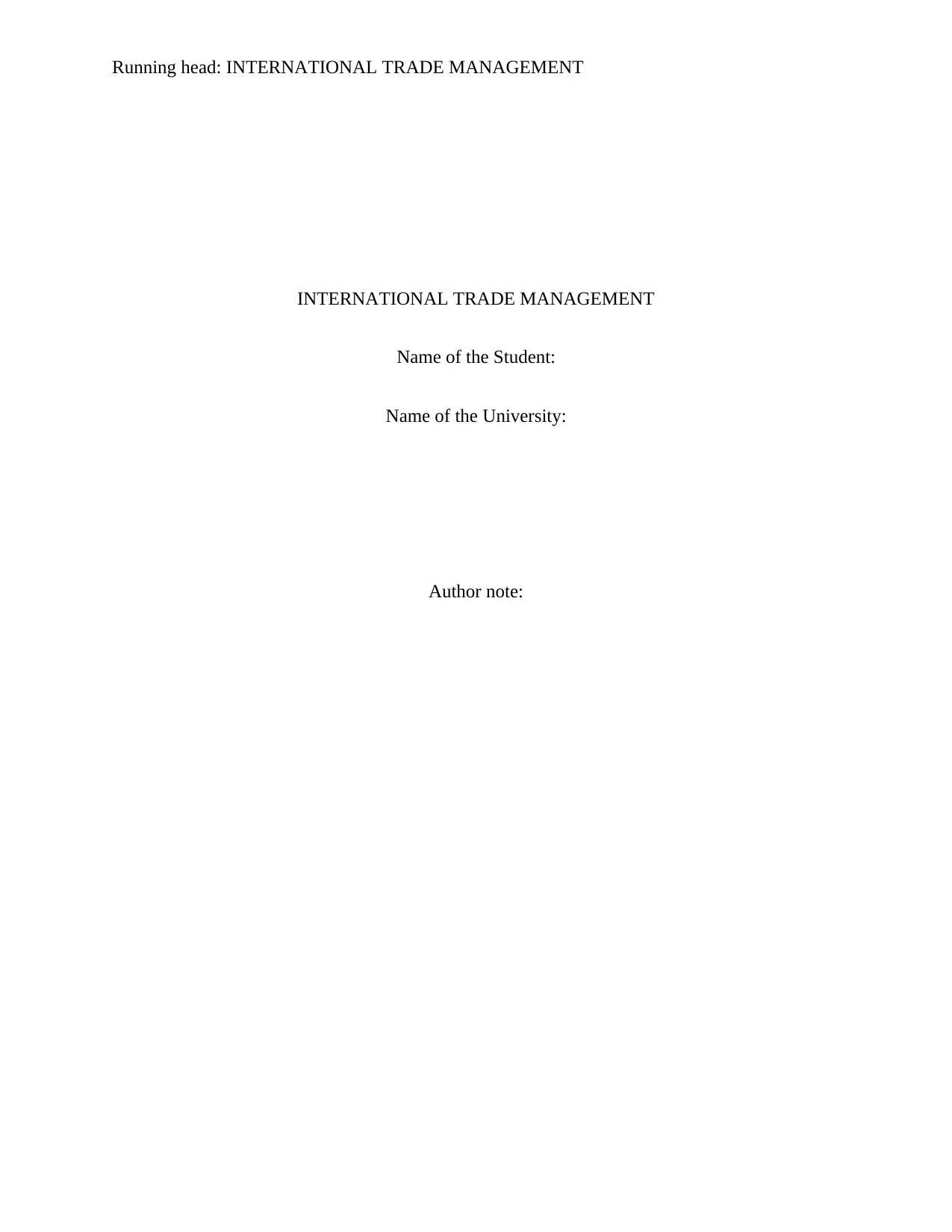
Running head: INTERNATIONAL TRADE MANAGEMENT
INTERNATIONAL TRADE MANAGEMENT
Name of the Student:
Name of the University:
Author note:
INTERNATIONAL TRADE MANAGEMENT
Name of the Student:
Name of the University:
Author note:
Secure Best Marks with AI Grader
Need help grading? Try our AI Grader for instant feedback on your assignments.
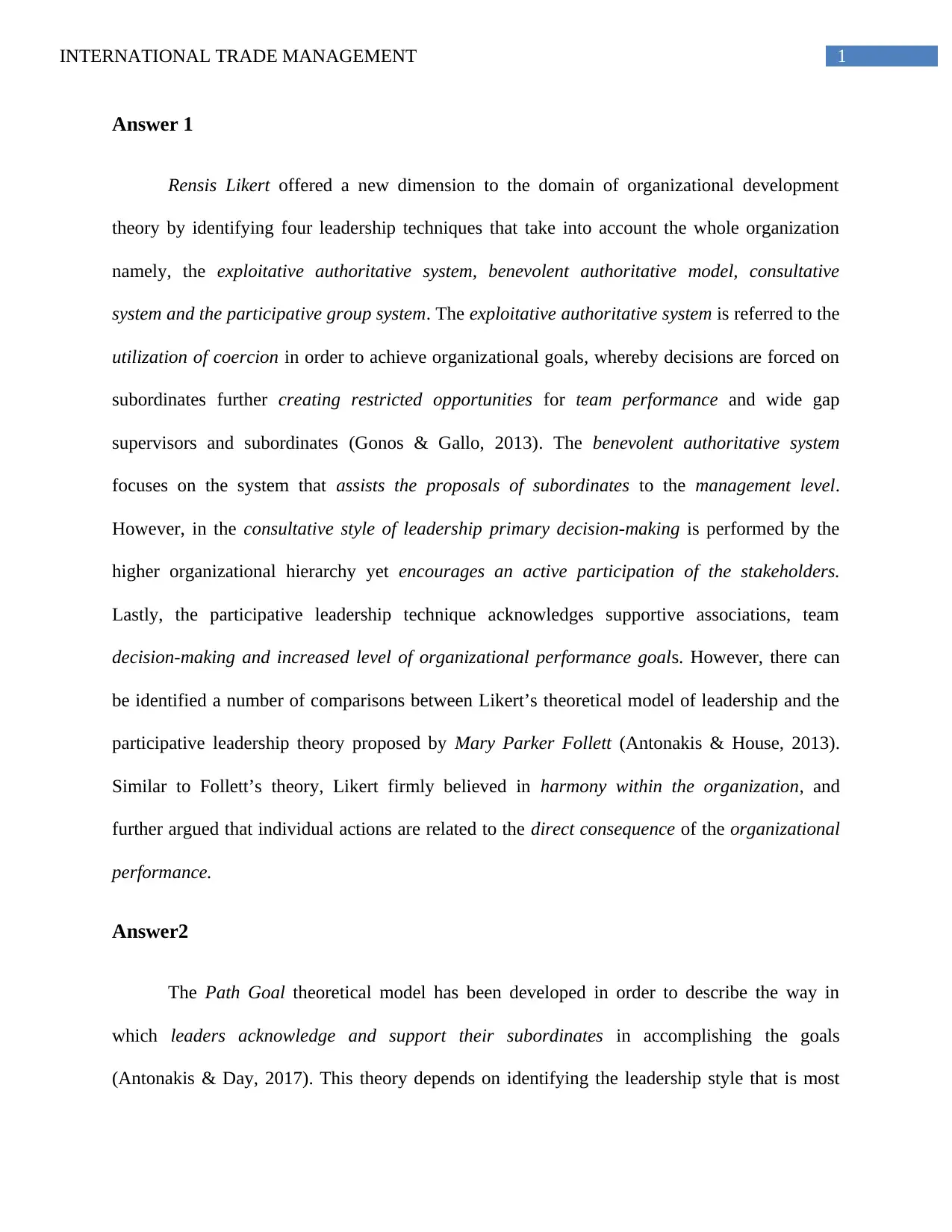
1INTERNATIONAL TRADE MANAGEMENT
Answer 1
Rensis Likert offered a new dimension to the domain of organizational development
theory by identifying four leadership techniques that take into account the whole organization
namely, the exploitative authoritative system, benevolent authoritative model, consultative
system and the participative group system. The exploitative authoritative system is referred to the
utilization of coercion in order to achieve organizational goals, whereby decisions are forced on
subordinates further creating restricted opportunities for team performance and wide gap
supervisors and subordinates (Gonos & Gallo, 2013). The benevolent authoritative system
focuses on the system that assists the proposals of subordinates to the management level.
However, in the consultative style of leadership primary decision-making is performed by the
higher organizational hierarchy yet encourages an active participation of the stakeholders.
Lastly, the participative leadership technique acknowledges supportive associations, team
decision-making and increased level of organizational performance goals. However, there can
be identified a number of comparisons between Likert’s theoretical model of leadership and the
participative leadership theory proposed by Mary Parker Follett (Antonakis & House, 2013).
Similar to Follett’s theory, Likert firmly believed in harmony within the organization, and
further argued that individual actions are related to the direct consequence of the organizational
performance.
Answer2
The Path Goal theoretical model has been developed in order to describe the way in
which leaders acknowledge and support their subordinates in accomplishing the goals
(Antonakis & Day, 2017). This theory depends on identifying the leadership style that is most
Answer 1
Rensis Likert offered a new dimension to the domain of organizational development
theory by identifying four leadership techniques that take into account the whole organization
namely, the exploitative authoritative system, benevolent authoritative model, consultative
system and the participative group system. The exploitative authoritative system is referred to the
utilization of coercion in order to achieve organizational goals, whereby decisions are forced on
subordinates further creating restricted opportunities for team performance and wide gap
supervisors and subordinates (Gonos & Gallo, 2013). The benevolent authoritative system
focuses on the system that assists the proposals of subordinates to the management level.
However, in the consultative style of leadership primary decision-making is performed by the
higher organizational hierarchy yet encourages an active participation of the stakeholders.
Lastly, the participative leadership technique acknowledges supportive associations, team
decision-making and increased level of organizational performance goals. However, there can
be identified a number of comparisons between Likert’s theoretical model of leadership and the
participative leadership theory proposed by Mary Parker Follett (Antonakis & House, 2013).
Similar to Follett’s theory, Likert firmly believed in harmony within the organization, and
further argued that individual actions are related to the direct consequence of the organizational
performance.
Answer2
The Path Goal theoretical model has been developed in order to describe the way in
which leaders acknowledge and support their subordinates in accomplishing the goals
(Antonakis & Day, 2017). This theory depends on identifying the leadership style that is most
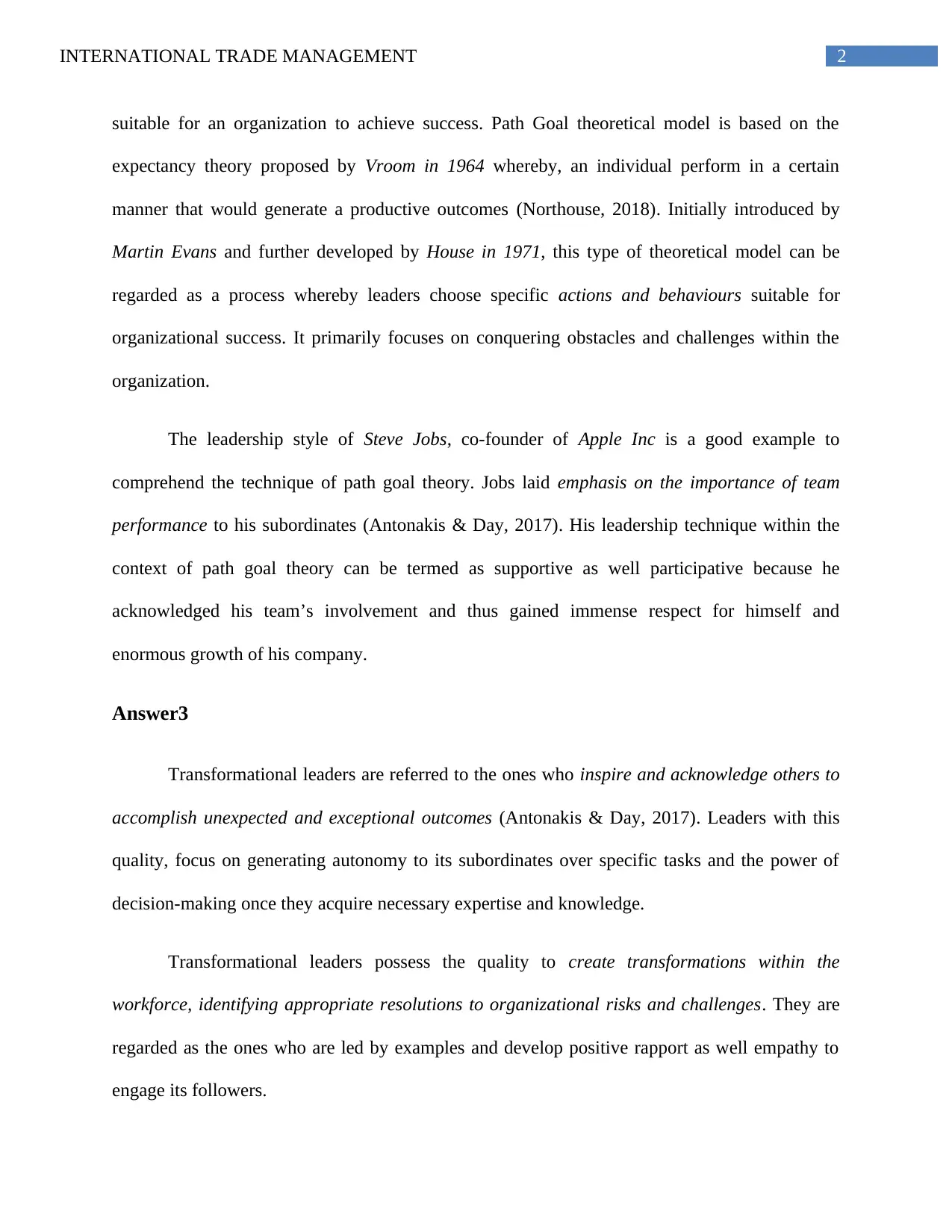
2INTERNATIONAL TRADE MANAGEMENT
suitable for an organization to achieve success. Path Goal theoretical model is based on the
expectancy theory proposed by Vroom in 1964 whereby, an individual perform in a certain
manner that would generate a productive outcomes (Northouse, 2018). Initially introduced by
Martin Evans and further developed by House in 1971, this type of theoretical model can be
regarded as a process whereby leaders choose specific actions and behaviours suitable for
organizational success. It primarily focuses on conquering obstacles and challenges within the
organization.
The leadership style of Steve Jobs, co-founder of Apple Inc is a good example to
comprehend the technique of path goal theory. Jobs laid emphasis on the importance of team
performance to his subordinates (Antonakis & Day, 2017). His leadership technique within the
context of path goal theory can be termed as supportive as well participative because he
acknowledged his team’s involvement and thus gained immense respect for himself and
enormous growth of his company.
Answer3
Transformational leaders are referred to the ones who inspire and acknowledge others to
accomplish unexpected and exceptional outcomes (Antonakis & Day, 2017). Leaders with this
quality, focus on generating autonomy to its subordinates over specific tasks and the power of
decision-making once they acquire necessary expertise and knowledge.
Transformational leaders possess the quality to create transformations within the
workforce, identifying appropriate resolutions to organizational risks and challenges. They are
regarded as the ones who are led by examples and develop positive rapport as well empathy to
engage its followers.
suitable for an organization to achieve success. Path Goal theoretical model is based on the
expectancy theory proposed by Vroom in 1964 whereby, an individual perform in a certain
manner that would generate a productive outcomes (Northouse, 2018). Initially introduced by
Martin Evans and further developed by House in 1971, this type of theoretical model can be
regarded as a process whereby leaders choose specific actions and behaviours suitable for
organizational success. It primarily focuses on conquering obstacles and challenges within the
organization.
The leadership style of Steve Jobs, co-founder of Apple Inc is a good example to
comprehend the technique of path goal theory. Jobs laid emphasis on the importance of team
performance to his subordinates (Antonakis & Day, 2017). His leadership technique within the
context of path goal theory can be termed as supportive as well participative because he
acknowledged his team’s involvement and thus gained immense respect for himself and
enormous growth of his company.
Answer3
Transformational leaders are referred to the ones who inspire and acknowledge others to
accomplish unexpected and exceptional outcomes (Antonakis & Day, 2017). Leaders with this
quality, focus on generating autonomy to its subordinates over specific tasks and the power of
decision-making once they acquire necessary expertise and knowledge.
Transformational leaders possess the quality to create transformations within the
workforce, identifying appropriate resolutions to organizational risks and challenges. They are
regarded as the ones who are led by examples and develop positive rapport as well empathy to
engage its followers.
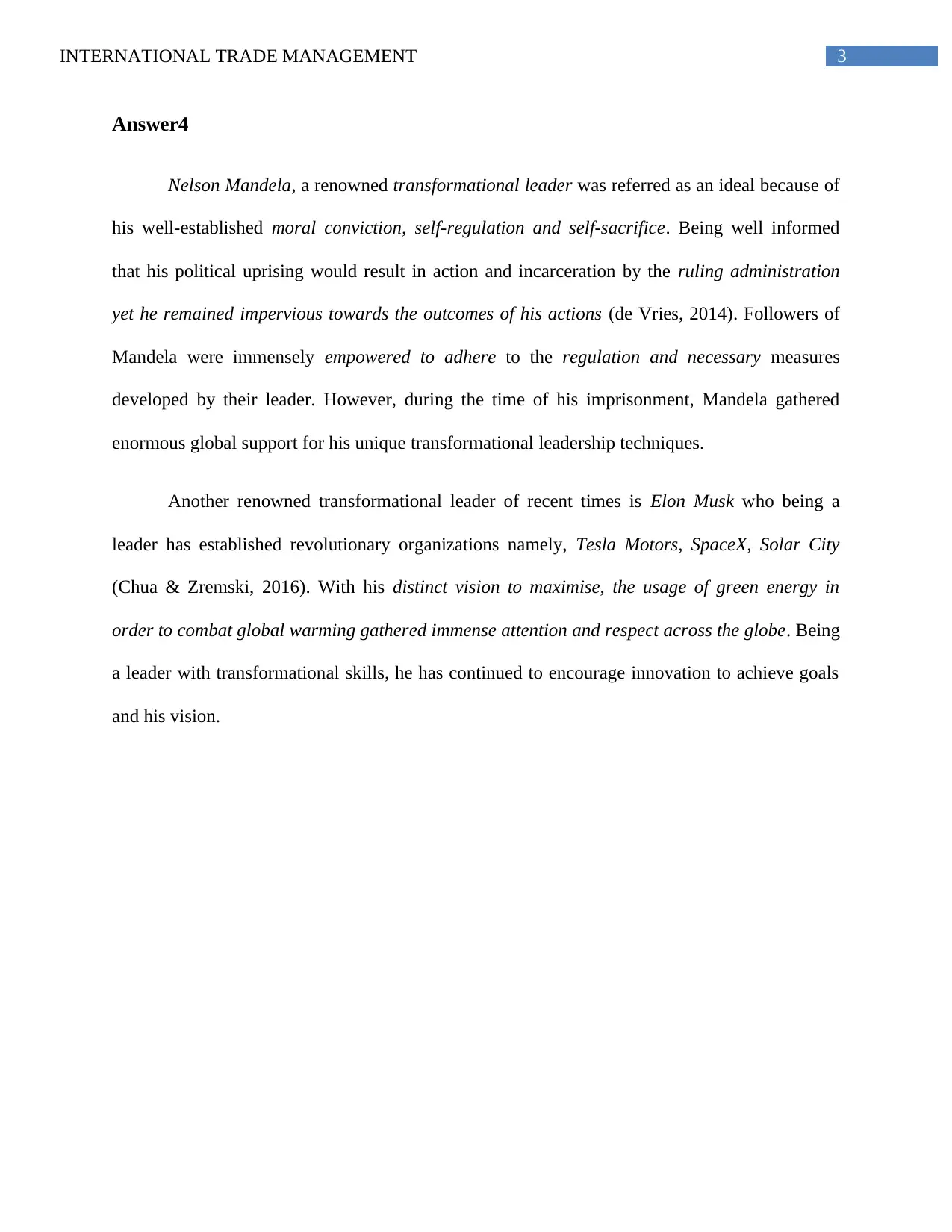
3INTERNATIONAL TRADE MANAGEMENT
Answer4
Nelson Mandela, a renowned transformational leader was referred as an ideal because of
his well-established moral conviction, self-regulation and self-sacrifice. Being well informed
that his political uprising would result in action and incarceration by the ruling administration
yet he remained impervious towards the outcomes of his actions (de Vries, 2014). Followers of
Mandela were immensely empowered to adhere to the regulation and necessary measures
developed by their leader. However, during the time of his imprisonment, Mandela gathered
enormous global support for his unique transformational leadership techniques.
Another renowned transformational leader of recent times is Elon Musk who being a
leader has established revolutionary organizations namely, Tesla Motors, SpaceX, Solar City
(Chua & Zremski, 2016). With his distinct vision to maximise, the usage of green energy in
order to combat global warming gathered immense attention and respect across the globe. Being
a leader with transformational skills, he has continued to encourage innovation to achieve goals
and his vision.
Answer4
Nelson Mandela, a renowned transformational leader was referred as an ideal because of
his well-established moral conviction, self-regulation and self-sacrifice. Being well informed
that his political uprising would result in action and incarceration by the ruling administration
yet he remained impervious towards the outcomes of his actions (de Vries, 2014). Followers of
Mandela were immensely empowered to adhere to the regulation and necessary measures
developed by their leader. However, during the time of his imprisonment, Mandela gathered
enormous global support for his unique transformational leadership techniques.
Another renowned transformational leader of recent times is Elon Musk who being a
leader has established revolutionary organizations namely, Tesla Motors, SpaceX, Solar City
(Chua & Zremski, 2016). With his distinct vision to maximise, the usage of green energy in
order to combat global warming gathered immense attention and respect across the globe. Being
a leader with transformational skills, he has continued to encourage innovation to achieve goals
and his vision.
Secure Best Marks with AI Grader
Need help grading? Try our AI Grader for instant feedback on your assignments.
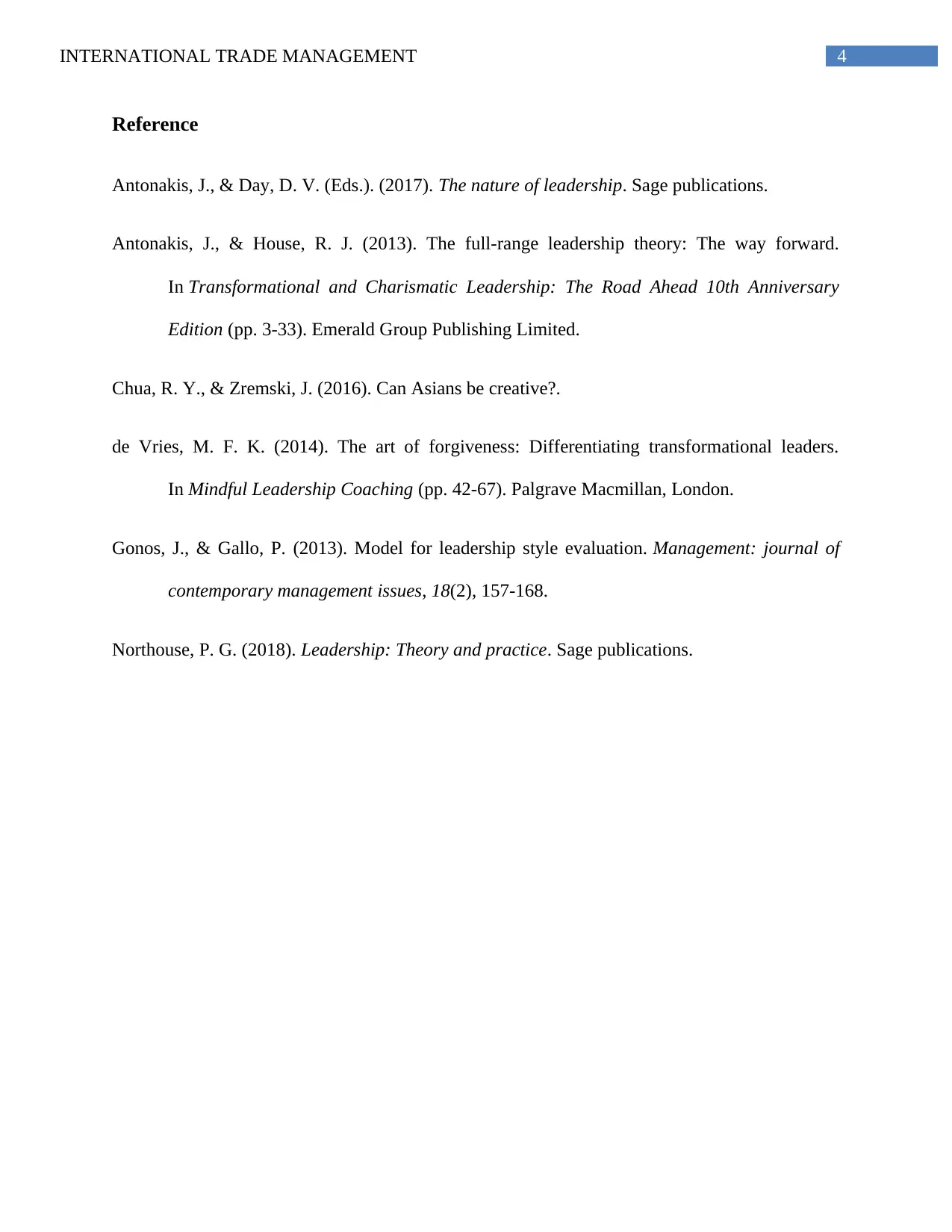
4INTERNATIONAL TRADE MANAGEMENT
Reference
Antonakis, J., & Day, D. V. (Eds.). (2017). The nature of leadership. Sage publications.
Antonakis, J., & House, R. J. (2013). The full-range leadership theory: The way forward.
In Transformational and Charismatic Leadership: The Road Ahead 10th Anniversary
Edition (pp. 3-33). Emerald Group Publishing Limited.
Chua, R. Y., & Zremski, J. (2016). Can Asians be creative?.
de Vries, M. F. K. (2014). The art of forgiveness: Differentiating transformational leaders.
In Mindful Leadership Coaching (pp. 42-67). Palgrave Macmillan, London.
Gonos, J., & Gallo, P. (2013). Model for leadership style evaluation. Management: journal of
contemporary management issues, 18(2), 157-168.
Northouse, P. G. (2018). Leadership: Theory and practice. Sage publications.
Reference
Antonakis, J., & Day, D. V. (Eds.). (2017). The nature of leadership. Sage publications.
Antonakis, J., & House, R. J. (2013). The full-range leadership theory: The way forward.
In Transformational and Charismatic Leadership: The Road Ahead 10th Anniversary
Edition (pp. 3-33). Emerald Group Publishing Limited.
Chua, R. Y., & Zremski, J. (2016). Can Asians be creative?.
de Vries, M. F. K. (2014). The art of forgiveness: Differentiating transformational leaders.
In Mindful Leadership Coaching (pp. 42-67). Palgrave Macmillan, London.
Gonos, J., & Gallo, P. (2013). Model for leadership style evaluation. Management: journal of
contemporary management issues, 18(2), 157-168.
Northouse, P. G. (2018). Leadership: Theory and practice. Sage publications.
1 out of 5
Related Documents
Your All-in-One AI-Powered Toolkit for Academic Success.
+13062052269
info@desklib.com
Available 24*7 on WhatsApp / Email
![[object Object]](/_next/static/media/star-bottom.7253800d.svg)
Unlock your academic potential
© 2024 | Zucol Services PVT LTD | All rights reserved.





